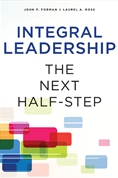
John P. Forman and Laurel A. Ross. Integral Leadership: The Next Half-Step.
blank
John P. Forman and Laurel A. Ross.  Albany, NY: Excelsior Editions, SUNY, 2013.
Albany, NY: Excelsior Editions, SUNY, 2013.
If you are looking for an introductory text that you can include in an undergraduate or Master’s course on leadership, here it is. In addition to laying out the elements of the Wilberian integral model in relation to leadership, the authors have accumulated many supporting examples from the literature, but little from direct experience. This is surprising since Forman is the Managing Director of Integral Development Associates in Seattle (although, he is the only individual listed on the staff of this consulting/coaching firm’s website). In fact, he and his associates are the only people I know who have given a workshop/presentation on integral leadership at the International Leadership Association conference (in Seattle, maybe eight years ago?). Laurel A. Ross is the Founding Director of Our Imagined Life and lives in British Columbia, Canada. She is the only individual listed on that site.
The book is grounded on the notion of the next leap in human consciousness “that may prove to be the next step in human evolution: a conscious integration of coevolution, global interdependency, self-organization, field theory, and more.” This will mean a “half-step” to a higher level of complexity.
The authors have laid out elements of the AQAL model and, particularly using the quadrants, have offered a usable introduction to integral mapping and meaning making. The emphasis on sense and meaning making is one of the strengths of the book. Another strength is the emphasis on practice. Too much of what the leadership industry has to offer in relation to development fails to promote the integration of practices into the daily lives of individuals and systems that support evolutionary and integral development.
Using Wilber’s variation on the theme of Spiral Dynamics (e.g., Amber instead of Blue) the authors lay out the meaning making systems of each stage, as well as what is required to lead others who have centers of gravity in these levels of development. They also examine collective meaning making. Here is the tricky area of culture and the questions of shared vs. diversity within cultures. Their approach is that collectives can share a center of gravity yet the challenge of leading in the current era is the complexity of human systems and the diversity represented within them. They call this “the dynamics of interacting sets of meaning.” I consider this an important step away from the traditional ways of approaching culture.
To characterize cultures, the authors draw on the Cook-Greuter/Torbert (Loevinger) model of Diplomats, Achievers, etc. I am not sure why they stepped away from the Spiral Dynamics model for this purpose since it lends itself so readily, not only to characterizations of elements of culture, but also the stratifications often found in human systems.
The integral perspective that they offer as being the next stage of development is essentially Yellow, a system of appreciating and seeking to integrate the diversity of other centers of gravity. It is individual and collective integrated. They also reference stakeholders in this discussion, a step above the shareholder frame of reference so often found in the literature. Here they talk about integrally developed individuals in leadership roles. This opens the door for me to wonder why the authors continue to perpetuate the conflation of terms like leader, leading, leadership. This is a serious flaw in the book.
In the final chapter, the authors state: “Here at the end of the book it may appear that we have not unveiled any new tools or techniques, any new strategic thinking process or change management approach or game-changing innovations.” Rather, they have offered a framework for bringing perspectives, practices and options to meet the challenges of current situations in a way that engages individual and collective meaning making. In concluding they demonstrate this by drawing on some models of teamwork, for example, that have been around for a long time.
And, despite the fact that there is little original work here, a strength of the book is that it is more about developing a lens that can be used to engage increasing complexity while drawing on past experience and learning. The book is another opening on the conversation of leading, leader and leadership, one that serves as a useful introduction to the field.
